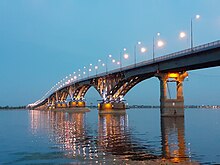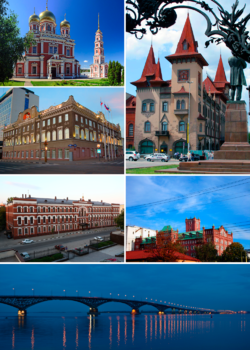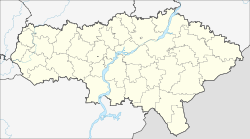Saratov
| city
Saratov
Саратов
|
|||||||||||||||||||||||||||||||||||||||||||
|
|||||||||||||||||||||||||||||||||||||||||||
|
|||||||||||||||||||||||||||||||||||||||||||
| List of cities in Russia | |||||||||||||||||||||||||||||||||||||||||||
Saratow ( Russian Саратов , ) is a city in the Russian Oblast of the same name . It has 837,900 inhabitants (as of October 14, 2010) and is located on the right, so-called “mountain bank” of the central Volga . Saratov is an important cultural and economic center as well as a university town and, together with Engels on the other side of the Volga, forms an agglomeration with around 1.2 million inhabitants.
geography
Geographical location
Saratov is located in the European part of Russia. The city lies on the edges of the hill country of the Volga plateau and extends to the banks of the Volga , which is dammed here to form the Volgograd reservoir . The city center is not far from the Volga. The Volga is about three kilometers wide here and is crossed by the Saratov Bridge near the city center .
City structure
Saratov is the administrative seat of the Saratov Oblast , which includes the greater Saratov area. While the Saratov Oblast is divided into 38 Rajons (districts), the city itself is divided into six districts (also called Rajon ).
| Rajon | Original name | Population (2009) |
|---|---|---|
| Wolschski | Волжский | 74,000 |
| Zavodskoi | Заводской | 189.056 |
| Kirowski | Кировский | 135,537 |
| Leninsky | Ленинский | 262,412 |
| Oktyabrsky | Октябрьский | 119.962 |
| Frunsenski | Рунзенский | 49,986 |
climate
| Saratov | ||||||||||||||||||||||||||||||||||||||||||||||||
|---|---|---|---|---|---|---|---|---|---|---|---|---|---|---|---|---|---|---|---|---|---|---|---|---|---|---|---|---|---|---|---|---|---|---|---|---|---|---|---|---|---|---|---|---|---|---|---|---|
| Climate diagram | ||||||||||||||||||||||||||||||||||||||||||||||||
| ||||||||||||||||||||||||||||||||||||||||||||||||
|
Average monthly temperatures and rainfall for Saratov
Source: Roshydromet
|
|||||||||||||||||||||||||||||||||||||||||||||||||||||||||||||||||||||||||||||||||||||||||||||||||||||||||
history
Saratov was founded as a tsar's fortress in 1590. Before that, the city was the "capital" of the Golden Horde , the Mongolian part of Eastern Europe and Western Siberia. Some historians suspect that the name of the city comes from the Tatar language and means something like "Yellow Mountain".
- According to an ukase from Tsar Fyodor Ivanovich , construction of a guard fortress began on the Volga in 1590, after Samara had been founded on the Volga in 1586 and Tsaritsyn in 1589 . This fortress was supposed to protect the steppe areas of Tsarist Russia on the Volga and contain the attacks of the horsemen from the neighboring areas. Securing the waterway from Kazan to Astrakhan , which ran here, was just as important . The fortress was built under the leadership of the military leader Grigory Sassekin . Saratov was no longer just an important military base, but also a major trading center as a hub for Russian trade with the Orient.
From the second half of the 18th century until the deportations in connection with the Second World War , numerous Volga Germans lived in Saratov , whose activities also left their mark on the city's architecture. Most of them came from Bavaria , Baden , Hesse , the Palatinate and the Rhineland and from 1763 to 1767 accepted the invitation of the German-born Tsarina Katharina II. After the attack of the “Third Reich” on the Soviet Union in June 1941, Josef Stalin left the presidium of the Supreme Soviet of the USSR on August 28, 1941 pass the decree “On the resettlement of Germans residing in the Volga region”. The Volga Germans were accused of collective collaboration , deported to Siberia and Central Asia and there forced into labor camps run by the “ Labor Army” (Трудармия), killing thousands.
During its heyday in the 19th century, the city was one of the largest in the Russian Empire .
With reference to the 1630s, there are written testimonials about Saratov from a travelogue in German, which also contains a picture of the city.
In the autumn of 1856 a seminary was founded in Saratov and a boys' seminary in 1857, which was to serve as a preparatory school for the seminary. In the boys' seminar, 25 places were reserved annually for children of the colonists; orphans and sons from poor families were preferred. Only about 20% of the boys' seminary graduates attended the seminary, the vast majority went to the colonies as teachers. Four graduates of the Saratov seminary, Anton Johannes von Padua Zerr (1849 to 1932), Dr. Josef Aloisius Keßler (1862 to 1933), Dr. Alexander Frison (1873 to 1937) and Dr. Markus Glaser (1880 to 1950) became diocesan bishops.
During the First World War , Saratov was the destination in January 1915 for deportation convoys of Germans, Jews, Hungarians, Austrians and Slavs, who were classified as a possible danger in the western areas of the Reich near the front.
After the dissolution of the Saratov Governorate in 1928, Saratov was initially the center of the Lower Volga Oblast in the Russian SFSR , which in the same year became the Lower Volga Krai, which existed until 1934 . In 1932 the Krai Center was relocated to Stalingrad . The Saratov Krai was formed in 1934 and finally in 1936 the Saratov Oblast, which still exists today .
The first person in space Yuri Gagarin studied at the Technical University in Saratov and, after his legendary flight in 1961, landed in Saratov Oblast.
Population development
| year | Residents |
|---|---|
| 1897 | 137.147 |
| 1939 | 372.002 |
| 1959 | 584.092 |
| 1970 | 757.330 |
| 1979 | 855.702 |
| 1989 | 904.643 |
| 2002 | 873.055 |
| 2010 | 837.900 |
| 2014 | 840 785 |
| 2016 | 843.460 |
Note: census data
Tourist Attractions
Saratov is an important cultural center on the Volga. The entire old town is very picturesque and there are numerous magnificent building ensembles from many centuries, for example in the former Deutsche Straße , today Uliza Nemezkaja , now called Kirow Prospect . Tourists and locals stroll on the Kirov Prospect, now a pedestrian zone, or on the promenade on the Volga. Magnificent examples of Art Nouveau are everywhere to be found in Saratov, such as the Villa Reineke of Fyodor Schechtel , he built the 1912th A church that is particularly worth seeing is the church of the icon of the Mother of God , built at the beginning of the 20th century . Relieve my suffering . It is worth taking a car trip over the three-kilometer-long old Volga bridge , which connects the center of Saratov with the town of Engels on the opposite bank of the Volga .

Radishchev Art Museum
One of the city's biggest tourist attractions is the Radishchev Art Museum, which opened on July 29, 1885, with over 16,000 exhibits. It was founded by Alexei Bogolyubov (1824-1896), the grandson of Alexander Radishchev . It is one of the largest museums in the world dedicated to Russian art.
Saratov Ethnological Museum
Founded in 1886, the museum with a large archaeological collection is housed in a magnificent neo-classical building.
Saratov Opera
The Saratower Opera was founded in 1803, it is not only because of the magnificent architecture that it is unique and has long enjoyed international fame.
Saratov Drama Theater
The Saratov Dramatic Theater is one of the oldest theaters in Russia. Founded in 1803, it can look back on over 200 years of history.
economy
In the Saratov area, extensive agriculture is practiced, especially in the Volga valley. In the industrial sector, there are mainly mechanical engineering, chemical and petroleum processing companies in Saratov. Due to the German traditions of the city, numerous German-Russian joint ventures are active in the Saratov area.
traffic
With the Saratov Airport, Saratov had an international airport with a few direct connections abroad as well as regular flights to other Russian metropolises and the Saratov-Dubki airport . The new Saratov-Gagarin Airport went into operation in August 2019 . In addition, long-distance railway lines and, last but not least, the Volga as a busy inland waterway, play a major role. Local public transport is carried by bus lines, trolley buses and trams . The city is the administrative seat of the Volga Regional Directorate of the Russian State Railways . The management not only operates all railway lines and the associated infrastructure in the Saratov area, but also a rail network over 4,237 kilometers long.
Motorways and, by Russian standards, well-developed highways lead from the city directly to the surrounding cities. Saratov is connected to the area around the Russian capital Moscow via a branch of the Russian trunk road R22 Kaspi . The European route 38 also runs along this route (from Hluchiw , Ukraine to Kyzylorda , Kazakhstan ). The city is connected to Nizhny Novgorod , Saransk and Penza via the R158 trunk road . Here it is crossed by the R228 , which leads from Syzran to Volgograd .
Three bridges cross the Volga:
- the Saratower railway bridge (built in 1935),
- the Saratov Bridge (built in 1965) and
- the new bridge in Saratov (built in 2000 and 2009).
culture and education
Culture
Saratov is considered a city of culture in the Volga region, on the one hand because of the long and important tradition of the city, on the other hand, of course, because of the extensive art collection, which is of global importance with 16,000 exhibits and works by old masters. There are also numerous theaters, cinemas and other large cultural and entertainment venues. There is a representative of the Goethe Institute and a German House in the city for cultural exchange . In Saratov there is an opera that has long been talked about beyond the Russian borders.
religion
Christianity
Russian Orthodox Church

In 1906 the Orthodox Church of the icon of the Mother of God "Alleviate my suffering" was built.
Roman Catholic Church
In Saratov, on February 11, 2002, the “Roman Catholic Administration for Catholics of the Latin Rite in the South of European Russia” became the Catholic diocese of St. Clement . In 2004 the diocese was recognized by the state and is therefore a kind of "registered association". The episcopal church is St. Peter and Paul .
Evangelical Lutheran Church
In 2018 it was 225 years since the Evangelical Lutheran Church of St. Mary was inaugurated in Saratov. It was right in the city center and was demolished in 1971. The congregation then gathered in various locations and began building a new church in 2008. A building was created that can accommodate over 200 people and has numerous small and large rooms. The inauguration of the new St. Mary's Church took place on May 13, 2018. The ambassador of the Federal Republic of Germany, Rüdiger von Fritsch , who - as an ordained Lutheran preacher - gave the festive sermon - also took part in the festive service.
education
Further educational institutions in Saratov are:
- Saratov State University (Chernyshevsky University)
- Building College Saratov
- Saratov University of the Interior Ministry of Russia
- Saratov Military Institute for Biological, Chemical and Radiation Protection
- Saratov Military Medical Institute
- Saratov State Agrotechnical University
- Saratov State Academy of Veterinary Medicine and Biotechnology
- Saratov State Medical University
- Saratov State Law Academy
- Saratov Vavilov State Agricultural University
- Saratov State Social and Economic University
- Saratov State Technical University
- Saratov State Conservatory
- Saratov State Pedagogical Fedin Institute
- Stolypin Academy of the Volga Region for civil service
- Faculty of the Russian State Public Technical University of Transportation
- Branch of the Military Artillery University
- Branch of the Russian State University of Commerce and Economy, Moscow
- Branch of the Russian Academy of Law of the Volga Region
The Saratov Theater School is known far beyond the borders of Russia. Many famous actors were trained here.
Sports
One of the city's most famous sports clubs is the HK Kristall Saratov ice hockey club , which takes part in the Wysschaja Hockey League (WHL). Its home arena is the multi-purpose hall Sport Palast Kristall , which was opened in 1969 and has almost 5,000 seats and is used not only for ice hockey games but also for events in various indoor sports as well as for concerts and exhibitions. The hall is also used by the BK Avtodor Saratov basketball club , which plays in the VTB United League .
In football, the city is or was represented by the club PFK Sokol Saratow , which played for several seasons in the highest Russian class, the Premjer League , but currently commutes between the one class lower Perwenstwo FNL and the third-class Perwenstvo PFL . The city has its own venue with the Lokomotiv Stadium, which opened in 1962 and can hold up to 15,000 spectators .
POW camp of the Second World War
In the city there was a prisoner of war camp 238 for German prisoners of war of the Second World War , which was relocated to Engels in autumn 1947 as camp 368 . Seriously ill people were cared for in the two prisoner-of-war hospitals 3631 and 5138 . South of the city was a cemetery where 70,000 prisoners of war were buried, and another cemetery with 2,000 dead was laid out on one of the surrounding hills.
sons and daughters of the town
The sons and daughters of the city of Saratov include the writers Nikolai Tschernyschewski (1828–1889), Konstantin Fedin (1892–1977), Nadeschda Mandelstam (1899–1980), Alexander Bek (1903–1972) and Erika Müller-Hennig (1908–1985), pastor Johannes Schleuning (1879– 1961), the politicians Alexei Rykow (1881–1938), Georgi Oppokow (1888–1938), Roman Abramowitsch (* 1966) and Olga Batalina (* 1975), the mathematicians Alexander Weinstein (1897–1979), Alexander Norden (1904– 1993), Wiktor Wagner (1908–1981) and Alexander Olschanski (* 1946), the physical chemist and Nobel Prize winner Nikolai Semjonow (1896–1986), the actors Boris Babotschkin (1904–1975), Boris Andrejew (1915–1982), Oleg Tabakow (1935–2018), Evgeni Mironow (* 1966) and Filipp Jankowski (* 1968), the ice hockey players Anatoly Fedotow (* 1966), Sergei Nikolajew (* 1972), Denis Platonow (* 1981) and Colonel General Boris Gromow (* 1943) .
Web links
- Brief portrait (German)
- Picture gallery of Saratov (Russian)
- City Council website (Russian)
- Saratov City Culture (Russian)
- Art from Saratov (German)
- Saratov: Home of the Volga Germans on Russia Beyond the Headlines: News from Russia
Individual evidence
- ↑ a b Itogi Vserossijskoj perepisi naselenija 2010 goda. Tom 1. Čislennostʹ i razmeščenie naselenija (Results of the All-Russian Census 2010. Volume 1. Number and distribution of the population). Tables 5 , pp. 12-209; 11 , pp. 312–979 (download from the website of the Federal Service for State Statistics of the Russian Federation)
- ↑ http://atlas.socpol.ru/portraits/sar.shtml
- ↑ http://diglib.hab.de/wdb.php?dir=drucke/263-2-hist-2f&pointer=409
- ↑ Adam Olearius (1656): Increased Newe Description of the Muscowitischen and Persischen Reyse: So happened by the opportunity of a Holstein embassy to the Russian Tsar and King in Persia; In what the opportunity of those places and countries / through which the Reyse passed / as Liffland / Russia / Tartaria / Meden and Persia / sampt the inhabitants nature / life / customs / house, world and spiritual status / carefully recorded / and with many mostly after Figures placed in life adorned / to be located. Which at the other time publishes Adam Olearius Ascanius / the Princely Governing Lords of Schleßwig Holstein Bibliothecarius and Hoff Mathematicus. (or urn ). Catalog entry Wolfenbüttel Digital Library (WDB)
- ^ Alfred Eisfeld : The Germans in Russia and in the Soviet Union , Eckartschriften Heft 97, Österreichische Landsmannschaft , Vienna 1986, page 58
- ↑ Sergej G. Nelipowitsch: The policy of the military leadership of Russia against the Germans during the First World War 1914-1918. In: Alfred Eisfeld et al. [Ed.] Germans in Russia and the Soviet Union 1914–1941. Lit Verlag, Berlin 2007.
- ^ Bishop Clemens Pickel's blog
- ↑ Julia Winogradowa / Dietrich Brauer , Church consecration again at last! In Saratow, St. Mary's Church was consecrated again after 225 years , in: Lutheran Service. Journal of the Martin Luther Association , 54th volume, 2018, issue 3, pp. 14–15
- ↑ Maschke, Erich (ed.): On the history of the German prisoners of war of the Second World War. Verlag Ernst and Werner Gieseking, Bielefeld 1962–1977.











